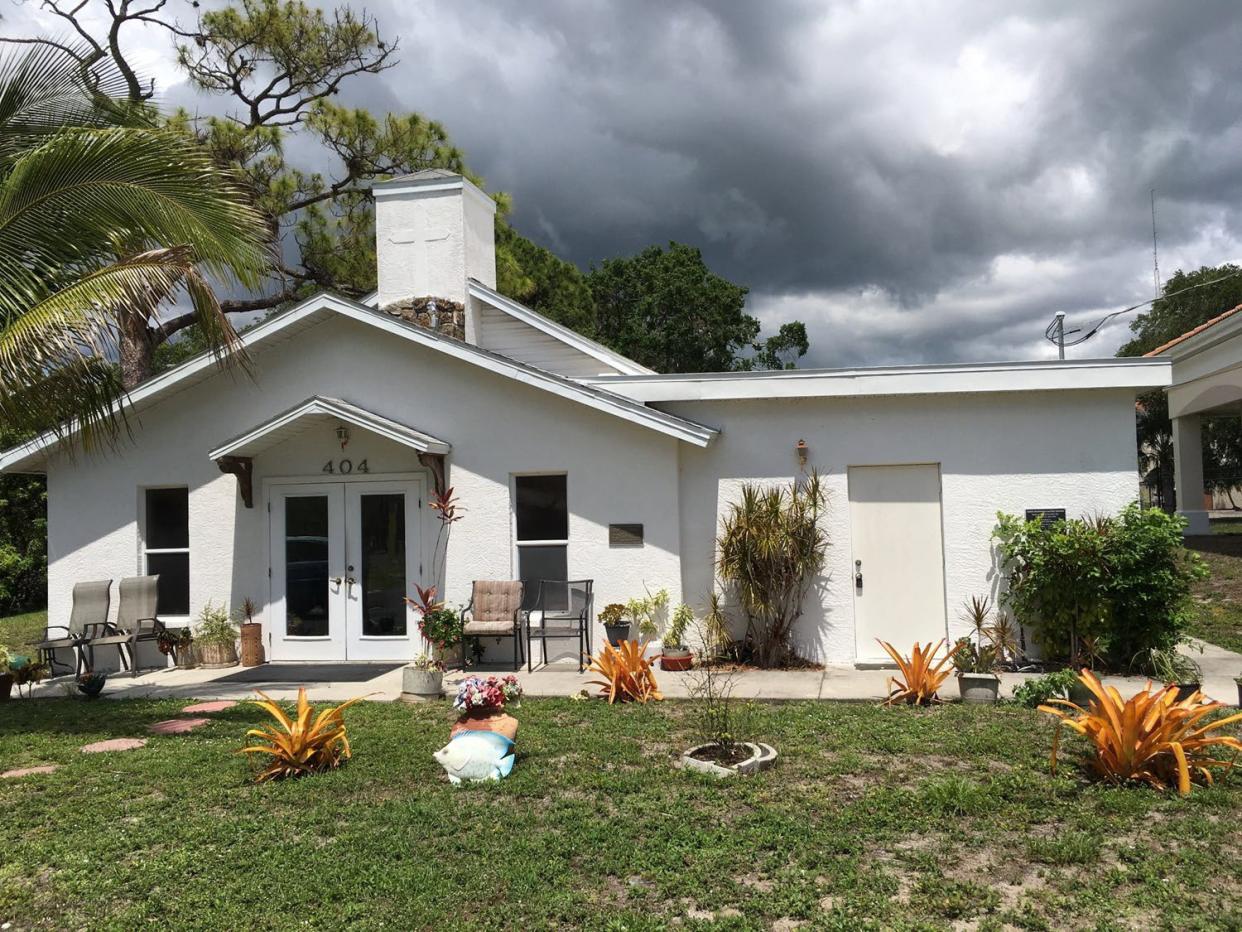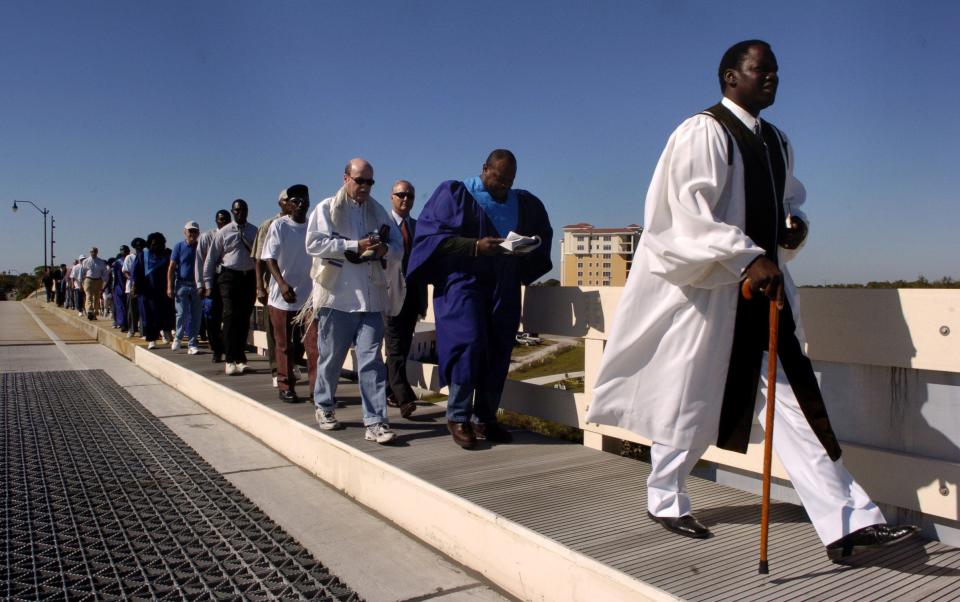Union Missionary Baptist Church moves closer to historical designation in Venice

VENICE – Union Missionary Baptist Church – a spiritual, social and educational hub of the African-American community in Venice that dates back to the era when the Brotherhood of Locomotive Engineers founded the city – moved a step closer to placement on the city’s register of historical resources by unanimous vote of the City Council Tuesday.
‘I’d like to say thank you for allowing us this great opportunity,” The Rev. James Mitchell, pastor of the church said after the vote.
“I just want to say thank-you, because you’re standing behind us because I was born and raised right here in Venice, in 1961, right here in this little place here,” Mitchell continued, as he held up a framed aerial photograph that showed the church, the city’s reverse-osmosis water treatment plant and an area once known as the Negro Quarters – where the George Fuller Construction Company built barracks to house its Black labor force.
Church flooding: Venice church rebounds from flooding
Rev. James C. Sims Sr. dies: Rev. Sims, who died Saturday, led Venice's only Black church
Security measures removed: Fenced-in church regains freedom
“This little place right here, that was a little church there and that was our kindergarten,” he continued, pointing out the structure that was built in 1955. “We couldn’t go to the normal, white kindergarten.”
According to the nomination application, since the 1920s, Venice’s Black community lived in the area of the city’s Edgewood District just east of the water plant and a Baptist church came about in 1934.
The Union Missionary Baptist Church was housed in the old barracks in the 1950s but a March 16, 1953 fire destroyed a couple of those buildings – including the one that housed the church.
The Rev. Joseph W. Daughtry and the congregation moved services to Laurel.
In 1954, Albert E. Blackburn – the owner of the land where the old Negro Quarters were built – donated a parcel at 404 Warfield Avenue North for a new church site.
A local architect donated his services, and a local builder donated surveying, and area businesses and churches either donated money or materials to the effort. Daughtry and the congregation opted to build the church themselves.
Daughtry, a mason and bricklayer, did the bulk of the work himself.
While still under construction, the church was dedicated Easter Sunday, 1955.
The Rev. James Sims succeeded Daughtry in 1959 and oversaw an expansion in 1960 for space that was used for education, recreation and dining.
The old Negro Quarters, where Mitchell was born, was replaced in the early 1970s by Grove Terrace, a public housing project just east of the church.
Since then, the church weathered a flood after a sewage pipe burst in 2003. It took two years to reopen the church; and Grove Terrace was replaced by Venetian Walk II.

“The only thing standing now is the church,” Mitchell said, who added that there are no Black-owned businesses in Venice and little evidence of Black history in the city.
Mitchell, who had seven siblings, and his family were an integral part of the Grove Terrace neighborhood.
“I would have hated to see the history demolished but you have done a wonderful job today, as brothers and sisters in Christ, I said you did a wonderful job by upholding us and allowing us to go into the register,” Mitchell said. “So therefore, we shall not be moved.”
A chance for federal grants
“It’s important because it’s a symbol of a piece of Venice history that we don’t talk about,” Venice Historical Resources Manager Harry Klinkhamer said in a telephone interview. “There was segregation; there is an African-American community in this city that really doesn’t get much talk of their existence."
Klinkhamer said that when the Venice Museum & Archives put together an African-American history exhibit – which was on display from Oct. 4, 2021 through July 27, 2022, they realized, after interviewing The Rev. Mitchell and members of the church, that the church is one of the last remnants of that history.
“This church symbolizes a community whose history has ties to Venice, all the way back to the BLE, that we never talk about,” he added.
There must still be a second reading of the ordinance placing the church on the local historical register for it to be official.
Among other things, the listing will allow the church to apply for a new grant program from the National Trust for Historic Preservation aimed at preserving historically Black churches.
In other Venice City Council action
On Monday, the Venice City Council:
• Approved the first reading of an ordinance approving a $130.8 million 2022-23 fiscal year budget, as well as a proposed property tax rate of 4.36 mills. Among additions approved by the council on Aug. 23 were $10,000 increases in funding for Venice Area Beautification Inc. and Venice MainStreet. Each program will receive $40,000 from the city. Also approved was a $5,000 pilot program for an artificial reef under the dock at Higel Park and a $1.3 million refund of building permit fees in the Building Fund. The final reading on the budget is set for 5:01 p.m., Sept. 26, at Venice City Hall, 401 W. Venice Ave.
• Approved a conditional use permit to allow for building unit heights taller than 42 feet for six multifamily buildings at 2600 Rustic Road and 1700 Ranch Road.
• Approved on a 4-0 vote, with Vice Mayor Nick Pachota recusing himself, an amendment to the ground lease with the Venice Pier Group to allow for an expansion of the existing solar field and an increase in the number of electric vehicle charging stations. Pachota’s family owns and operates Venice Pier Group.
• Approve a legislative referral directing staff to draft ordinance revisions to prohibit smoking at public beaches and parks, consistent with the Florida Clean Air Act.
Earle Kimel primarily covers south Sarasota County for the Herald-Tribune and can be reached at earle.kimel@heraldtribune.com. Support local journalism with a digital subscription to the Herald-Tribune.
This article originally appeared on Sarasota Herald-Tribune: Venice Baptist church closer to historical designation

